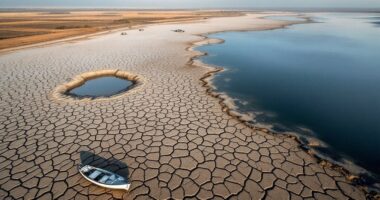Watershed protection safeguards water quality by preserving natural filtration systems worth over $450 billion nationally. Smart land use planning, conservation efforts, and aquatic buffers prevent contamination at the source, saving communities billions in treatment costs. From no-till farming to proper disposal of household chemicals, both individual actions and coordinated management strategies are essential. With 40-50% of U.S. waters already impaired, these protection methods offer cost-effective solutions for environmental health and economic stability. The deeper you explore watershed protection, the clearer its crucial importance becomes.

Safeguarding our watersheds stands as one of the most critical environmental endeavors of our time. These essential ecological systems don’t just quench our thirst; they’re economic powerhouses supporting over $450 billion in activities across the nation. Yet despite their importance, 40-50% of U.S. waters are either impaired or threatened – that’s like having almost half your body’s blood vessels clogged and expecting peak performance!
Watersheds: nature’s lifelines, economic engines worth billions, yet half are failing—like running a marathon with clogged arteries.
Healthy watersheds work like nature’s Brita filters, trapping sediments and filtering out contaminants before they reach our drinking glasses. They prevent erosion better than any man-made solution and help us avoid those dreaded “boil water before use” emergencies that nobody wants to receive in their news alerts. The protection of these aquatic ecosystems isn’t just environmentally sound – it’s economically brilliant.
So how do we keep these watery wonders functioning? Smart land use planning is key, managing development to prevent excessive impervious cover (that’s pavement and buildings to the rest of us). Land conservation through acquisitions and easements preserves critical areas, while aquatic buffers act like Nature’s bouncer, keeping troublemakers away from streams and shorelines. The establishment of these buffer zones physically separates water resources from potential pollution sources, creating a natural barrier of protection. Better site design minimizes hard surfaces, and proper erosion control at construction sites keeps dirt where it belongs – not in our waterways.
Watershed management operates like a well-organized sports league, coordinating activities by major basins and involving multiple agencies in scheduled monitoring and planning. The playbook includes thorough management plans with regular updates and implementation strategies between seasons.
Individual actions matter tremendously. Simple steps like proper disposal of household hazardous waste, picking up pet waste, judicious application of lawn chemicals, and keeping yard debris out of streets collectively create massive positive impacts.
Effective protection strategies balance human needs with environmental priorities, prohibiting access to sensitive areas while allowing recreation in others. Implementing no till farming practices helps prevent soil erosion while maintaining nutrients in fields rather than letting them wash into waterways. Programs from the EPA, state agencies, and local governments provide the regulatory framework, but it’s the combination of policy, community engagement, and individual responsibility that truly safeguards these precious resources for generations to come.
Frequently Asked Questions
How Can Individuals Contribute to Watershed Protection at Home?
Homeowners can become watershed heroes with simple daily actions. Installing rain barrels captures roof runoff while using eco-friendly cleaning products prevents harmful chemicals from entering waterways. Creating rain gardens with native plants helps filter stormwater naturally.
Reducing impervious surfaces, fixing leaky pipes, and properly disposing of household chemicals all contribute considerably. Even small steps like picking up pet waste and minimizing fertilizer use protect our shared water resources for generations to come.
What Pollutants Pose the Greatest Threat to Watersheds?
Excess nutrients from agricultural runoff represent the most pervasive watershed threat, triggering harmful algal blooms and oxygen depletion.
Industrial heavy metals and persistent chemicals pose long-term risks due to their toxicity and bioaccumulation potential.
Urban stormwater delivers a toxic cocktail of oils, road salts, and bacteria during rain events.
Of increasing concern are “forever chemicals” like PFAS, which resist breakdown and can contaminate drinking water supplies at even minuscule concentrations.
How Do Climate Change Impacts Affect Watershed Management?
Climate change substantially reshapes watershed management strategies. As rainfall patterns become unpredictable, managers must adapt to both flooding and drought conditions, often in the same region.
Higher temperatures alter water quality, accelerating harmful algal blooms and reducing dissolved oxygen. Infrastructure designed for historical conditions frequently proves inadequate.
Modern watershed management requires climate-resilient approaches like green infrastructure, enhanced monitoring systems, and natural ecosystem restoration to buffer against increasingly extreme weather events and changing hydrological cycles.
What Economic Benefits Result From Watershed Protection Programs?
Watershed protection programs yield substantial economic dividends across multiple sectors. They reduce water treatment costs by up to 20% for every 10% increase in forest cover, saving cities billions compared to building filtration plants.
These initiatives generate nearly 40 jobs per $1 million invested and prevent significant flood damage—up to $42,111 per acre of wetlands. Additionally, they enhance property values, support recreation revenues, and sustain millions of jobs in sectors dependent on clean, reliable water resources.
How Are Watersheds Monitored for Effectiveness of Protection Measures?
Watershed monitoring involves tracking both ecological health and protection measure effectiveness through multiple lenses. Scientists deploy a monitoring toolkit including water quality sampling, flow measurements, and macroinvertebrate surveys (nature’s canaries in the coal mine).
Effectiveness assessment requires baseline data collection, strategic sampling across the watershed, and patience—water quality improvements often take 5-10 years to materialize. Modern approaches incorporate GIS analysis, watershed health indices, and even citizen science to expand data collection while keeping costs manageable.









